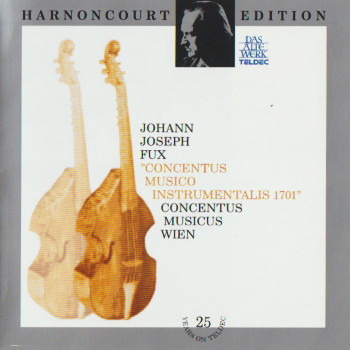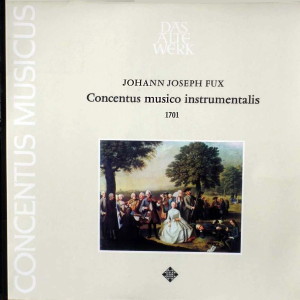 |
1 CD -
Teldec 8.41271 XH (c) 1989
|
 |
| 1 LP -
Telefunken SAWT 9619-A (p) 1970 |
|
| NIKOLAUS HARNONCOURT - 25 Years
on TELDEC |
|
|
|
|
|
|
|
| Johann Joseph
Fux (1660-1741) |
"Concentus Musico
instrumentalis... 1701" |
|
|
|
|
|
|
|
|
|
Serenada
à 8 für 3 Clarinen, 2 Oboen,
Fagott, 2 Violinen, Viola und B.c. |
|
34' 49" |
|
|
-
Marche, Allegro |
2' 11" |
|
A1 |
|
- Guigue,
Prestissimo |
1' 26" |
|
A2 |
|
-
Menuet |
2' 16" |
|
A3 |
|
-
Aria, più Allegro |
3' 26" |
|
A4 |
|
-
Ouverture |
3' 43" |
|
A5 |
|
-
Menuet I, Trio, II
|
3' 19" |
|
A6 |
|
-
Guigue, Prestissimo |
1' 09" |
|
A7 |
|
-
Aria, Andante
|
3' 23" |
|
A8 |
|
-
Aria |
0' 50" |
|
A9 |
|
-
Bourée I, II
|
2' 11" |
|
A10 |
|
-
Intrada |
3' 21" |
|
B1 |
|
-
Rigadon |
0' 51" |
|
B2 |
|
-
Ciacona |
2' 58" |
|
B3 |
|
-
Guigue, Prestissimo
|
0' 57" |
|
B4 |
|
-
Menuet |
2' 11" |
|
B5 |
|
-
Final, poco allegro
|
0' 37" |
|
B6 |
|
Rondeau
à 7 für Violino piccolo,
Fagott,, Violine, 3 Violen und B.c.
(Violino piccolo e Fagotto conc.: 3
4 Violins cn il Basso continuo) |
|
4' 16" |
B7 |
|
Sonata
à Quattro für Violine, Zink,
Posuane, Dulcian und Orgel |
|
8' 41" |
|
|
-
Allegro |
3' 36" |
|
B8 |
|
-
Adagio |
2' 02" |
|
B9 |
|
-
Allegro |
3' 03" |
|
B10 |
|
|
|
|
|
| Don
Smithers, Zink |
|
| CONCENTUS MUSICUS
WIEN (mit Originainstrumenten) |
|
| Nikolaus
HARNONCOURT, Leitung |
|
|
|
|
|
Luogo
e data di registrazione |
|
Casino
Zögernitz, Vienna (Austria) -
marzo, giugno e settembre 1969 |
|
|
Registrazione:
live / studio |
|
studio |
|
|
Producer
|
|
Wolf
Erichson |
|
|
Edizione CD |
|
TELDEC
- 8.41271 XH (244 690-2) - (1 CD -
durata 48' 12") - (c) 1989 - ADD |
|
|
Originale LP
|
|
TELEFUNKEN
- SAWT 9619-A - (1 LP - durata 48'
12") - (p) 1970 - Analogico |
|
|
Note |
|
-
|
|
|
|
|
|
The veil of mystery
surrounding the life history and
musical education of Johann
Joseph Fux has still not been
lifted. When he was
approximately thirty years old,
he suddenly appeared as a
finished musician in Vienna
where he worked mainly as an
organist. The emperor heard him
at the home of a nobleman and
named him Court Composer (the
title was created especially for
him) in 1698. Later he entered
the court orchestra and was
named conductor of the imperial
court orchestra. - As a
composer, Fux has not been held
in the esteem he merits. That is
probably because he was the
author of the famous manual on
counterpoint Gradus ad Parnassum
(the work from which the
\/iennese classicists still drew
their technical knowledge), and
because no one was willing to
believe that a theoretician
could also be a full-blooded
musician. Even today, a musician
who can express himself on the
subject of music is usually
stamped a dry theoretician. The
popular picture of the "artist"
shows him surrounded by a magic
aureole; intellect does not fit
into that picture. Fux
personally took another view of
himself: "...at the time in
which l was not yet in full use
of my reason, I was swept away
by the vehemence of some urge
that could not identify; it
directed all of my thoughts and
feelings toward music, and even
now I am permeated by an almost
miraculous desire to learn to
master it, indeed, I am pushed
in that direction as if I had no
will of my own; day and night my
ears seem surrounded by sweet
rnusical tones, so that I have
no reason to doubt the virtue of
my choice of profession."
In his "Concentus musico
instrumentalis... 1701", that he
dedicated to Leopold's son
Joseph I, he presented a
collection of sonatas and suites
with highly varying
instrumentations. ln these works
the French and Italian styles
pervade each other and are
blended with influences that
stem from Austrian folklore.
These works must probably also
be considered to be typical of
Austria's contribution to the
baroque concert of notions.
The Serenade on this
record is the opening piece of
this collection; it is a suite
with sixteen movements. The
versatile employment of the
valveless trumpet is
particularly interesting: in
three movements it comes forth
festively resounding, in the
other movements its line is
delicate and cantabile. The
composer apparently wanted to
demonstrate all of the
instruments possibilities. But
even aside from the trumpet the
scoring is remarltable. There
are solo passages for the oboes
like those that loter appeared
in Handel's Concerti grossi. The
individual movements are in part
free fantasy forms (Marche,
Aria, Aria, lntrada, Finale), in
part dances or the movements of
the French overture suite
(Guigue, Menuet Ouverture,
Menuet l, ll, Guigue, Aria
[Passepied] Bourrée I,
ll, Rigadon, Ciacona,
Guigue, Menuet). But Fux by no
means kept strictly to a formal
pattern in the movements. To the
Guigue, Ciacona and Menuet he
wrote a free solo part for the
trumpet: elements of peasant
music from his native Styria can
be heard repeatedly, for
example, in several minuets, but
especially in the completely
unorthodox Ciacona that at times
sounds just like a Ländler.
The other two pieces on this
recording were found in the
Dresden State Library;
The Rondeau a 7 was
included in this collection
chiefly for its unusual solo
group. A simple dance-like theme
(that is played by all
instruments eleven times with
slight rhythmic and dynamic
variation) forms a framework for
the soli and duets of the
violino piccolo and the bassaon.
The Sonata a
Quattro requires exactly
the same instruments as
Schmelzer's Carioletta, a
generation later, however; hence
it is considerably clearer and
smoother, a masterpiece of
four-port chamber musrc, scored
for four entirely different
sounding instruments; thus the
individual voices always remain
independently clear and maintain
their presence throughout the
contrapuntal structure.
|
|

